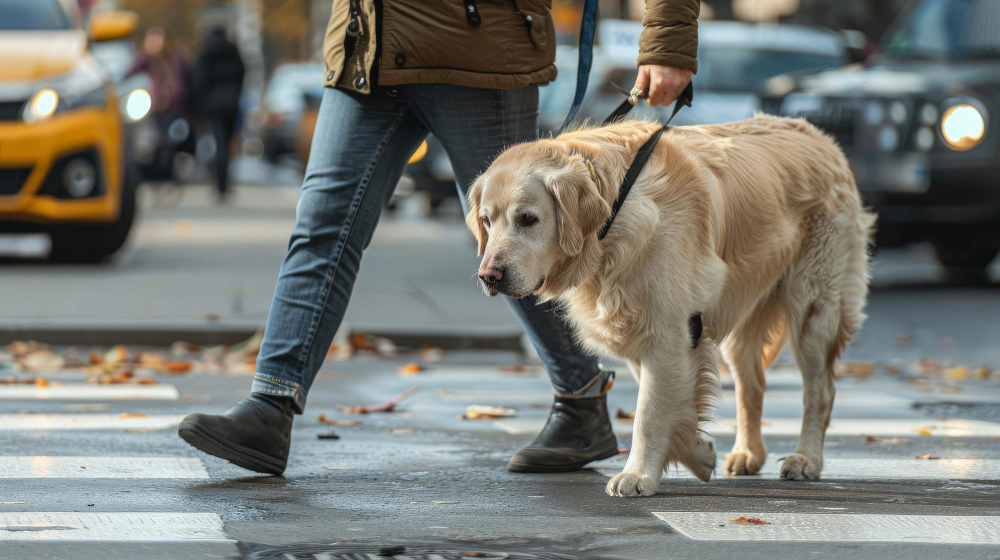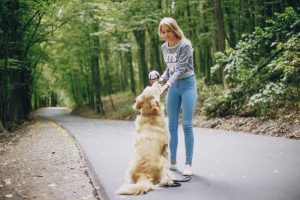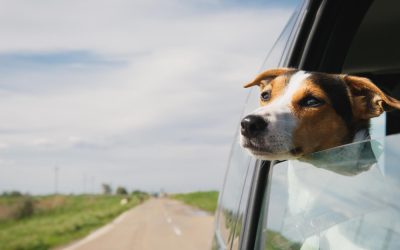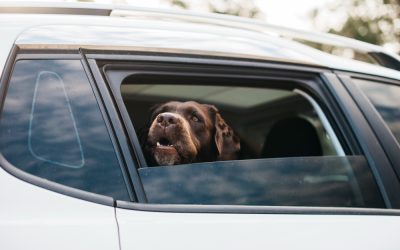The Guide To Walking Your Dog [12 Tips]

Walking your dog isn’t just a part of their daily routine; it is a physical activity for dogs, especially puppies, who use it as mental stimulation. Additionally, walking with your dog helps you train them and strengthens your bond, making your relationship more caring and loving.
Here are 12 practical tips to make your dog-walking experience more enjoyable for you and your furry friend.
1. Gear Up To Make Walking More Comfortable
Before walking your dog, you should get the right gear to make walking more comfortable.
- Harness: Choose one that fits snugly. If your dog tends to pull, a front-clip harness can help, giving you better control.
- Leash: Opt for a 4-6 foot leash for the perfect balance of freedom and control. A sturdy leash will help keep your dog safe by preventing them from running into dangerous situations or rough terrain. The leash is meant to train your dog, but in certain regions (e.g. Denver’s leash law), not walking your dog on a leash is illegal in public areas.
- ID Tags: Even with a microchip, ID tags are crucial—think of them as your dog’s license.
- Poop Bags: Always bring extra supplies to avoid any awkward situations. This is especially important in busy urban parks with strict guidelines.
2. Choose The Right Time That Works For Both Of You
Choosing the right time to walk can make a big difference, both for you and your dog.
- Morning Walks: Great for burning off energy and setting a positive tone for the day.
- Evening Strolls: Perfect for winding down and relaxing before bedtime.
- Avoid Midday Heat: Hot pavement can hurt your dog’s paws, so avoid walking in the afternoon during the summer.
- Winter Walks: Midday might be ideal for soaking up some sun and warmth in colder months. Remember to dress your dog in warm clothes.
3. Walk your dog 70% of the time, and let them spend the remaining 30% sniffing the environment and exploring
The number of daily walks depends on your dog’s breed, age, and energy level.
Typically, adult dogs need 1-2 walks a day. However, puppies & high-energy breeds (such as Border Collies, Australian Shepherds, Jack Russell Terriers, Siberian Huskies, Labrador Retrievers, etc.) may require 3-4 shorter walks to burn off all that extra energy.
However, it’s not just about the number of walks you take; it’s also about training their sense of smell. A dog’s sense of smell is 10,000 to 100,000 times stronger than a human’s, which led Colleen Demling-Riler, an in-house dog behavior expert at Dogtopia, to research this topic. The results showed that you should guide your dog 70% of the time during walks and allow them to spend the remaining 30% sniffing the environment and exploring.
4. Teaching Your Dog to Walk Nicely on a Leash
Leash manners can make or break a walk, but your dog can learn to walk calmly with patience and consistency.
- Start Still: Stand quietly, letting your dog explore. Reward them when they pay attention to you.
- Encourage Focus: Use treats and praise to keep your dog close by.
- Respond to Pulling: Stop walking when your dog pulls. Reward them when they come back to you.
- Short, Consistent Sessions: Keep training sessions brief but regular for the best results.
5. Switch Up Your Routine To Keep Their Senses Engaged
Walking the same route every day can become boring for your dog. Switch up your routine to keep their senses engaged by exploring new streets or parks and trying different terrains, such as grass, sand, or trails, which offer new sensory experiences and smells. You can also hide treats along your route to create a fun, interactive game where your dog gets to find them.
6. Add Some Exercise With Interval Training And Fetch
Add physical exercises for your dog, such as interval training and fetch. Alternate between walking and jogging to create an interval workout for your dog, and bring a ball for short play breaks.

7. Turn Walks Into A Training Opportunity
Each walk is a chance to reinforce good behavior.
- Stop and Wait: If your dog pulls, stop and wait for the leash to slack before continuing.
- Change Direction: Randomly changing directions keeps your dog focused on you.
- Heel Command: Teach your dog to walk beside you for better control in busy areas.
- Curb “Sit” Practice: Use the “sit” command at every curb for added safety.
- “Leave It” Command: Helps prevent your dog from grabbing dangerous objects off the ground.
8. Stay Alert And Aware Of Potential Distractions
Walking your dog also comes with potential distractions, especially when they catch sight of things they find interesting. So, make sure to supervise your dog and the environment for potential distractions, such as:
- Watch for Cars & Other Dogs: Before crossing any streets, be sure to watch for cars and other dogs that might trigger a reaction from your dog. Keep your dog close to you and under control.
- Monitor Body Language: If your dog appears stressed or nervous, it may be time to head home.
- Avoid Street Snacks: Be cautious of discarded food and similar items, especially on grass and parking lots, as they may contain harmful substances and real poisons for dogs.
9. Keep Your Dog Hydrated
Always carry water with you, even during winter walks, and offer your dog water every 15 to 20 minutes on longer outings.
Water is crucial in transporting important nutrients in and out of the dog’s body cells, aiding digestion and nutrient absorption. It helps regulate body temperature, improves cognitive function, and cushions the brain and spinal cord.
Read this article about ‘Guide to Keeping Your Dog Hydrated’ to learn more about your dog’s dehydration symptoms.
10. Read Your Dog’s Body Language And Know When It’s Time To Start Heading Back Home
If you notice any of the following symptoms of exhaustion, it’s time to start heading back home:
- Excessive Panting: This can indicate overheating or overexertion.
- Slowing Down: If your dog is dragging behind, it’s a sign they may be tired.
- Heat Exhaustion Signs: Look for drooling or wobbling, especially during hot weather.
11. Offer Your Dog Plenty Of Praise And Affection As You Wrap Up The Walk
An older study notes that when a familiar individual greets the dog with both voice and touch, oxytocin levels increase significantly more than when the greeting involves voice alone.
Therefore, always end each walk on a positive note with both verbal praise and physical affection.
12. Be Prepared For Any Weather
Adjust your routine based on the weather to ensure your walks are safe and comfortable.
- For Hot Days: Walk early in the morning or later in the evening.
- For Cold Weather: A c ozy dog jacket can keep your dog warm on chilly walks.
- For Rainy Days: Bring a towel to dry your dog off after the walk and prevent that wet dog smell.



